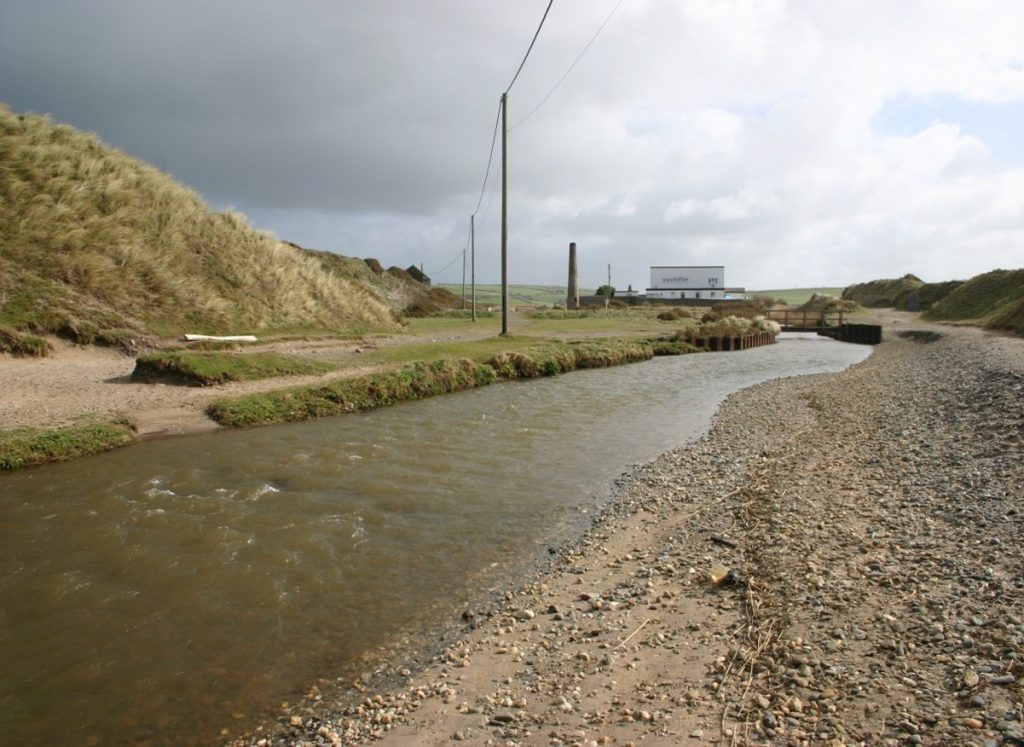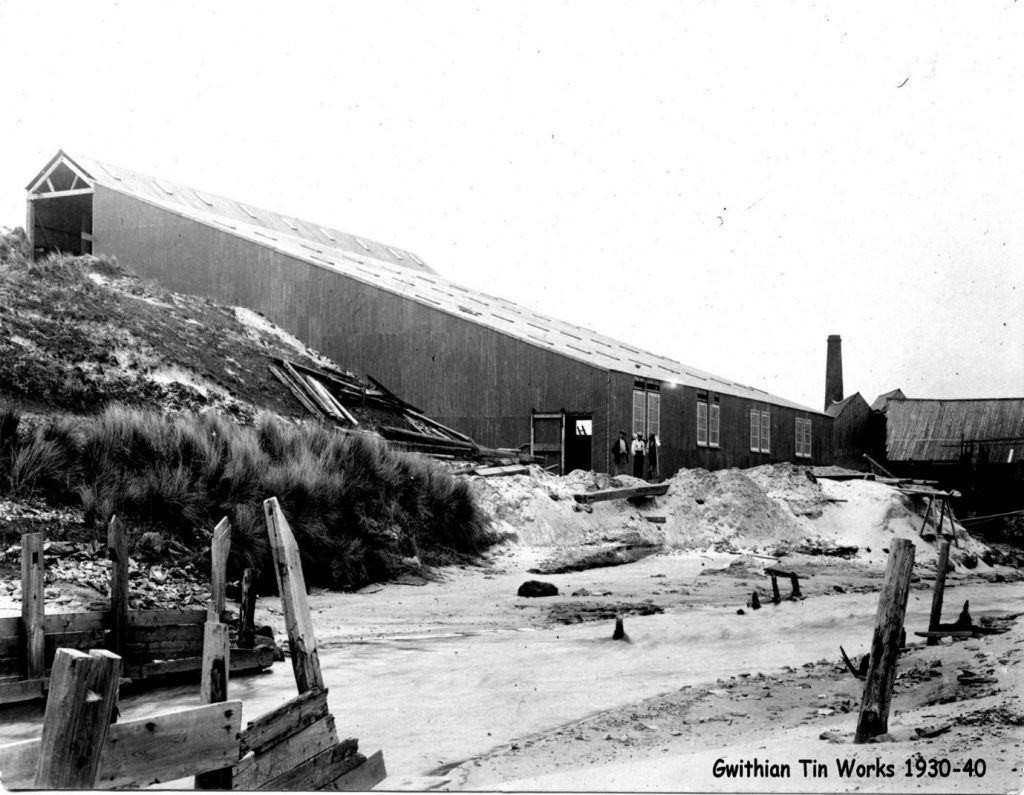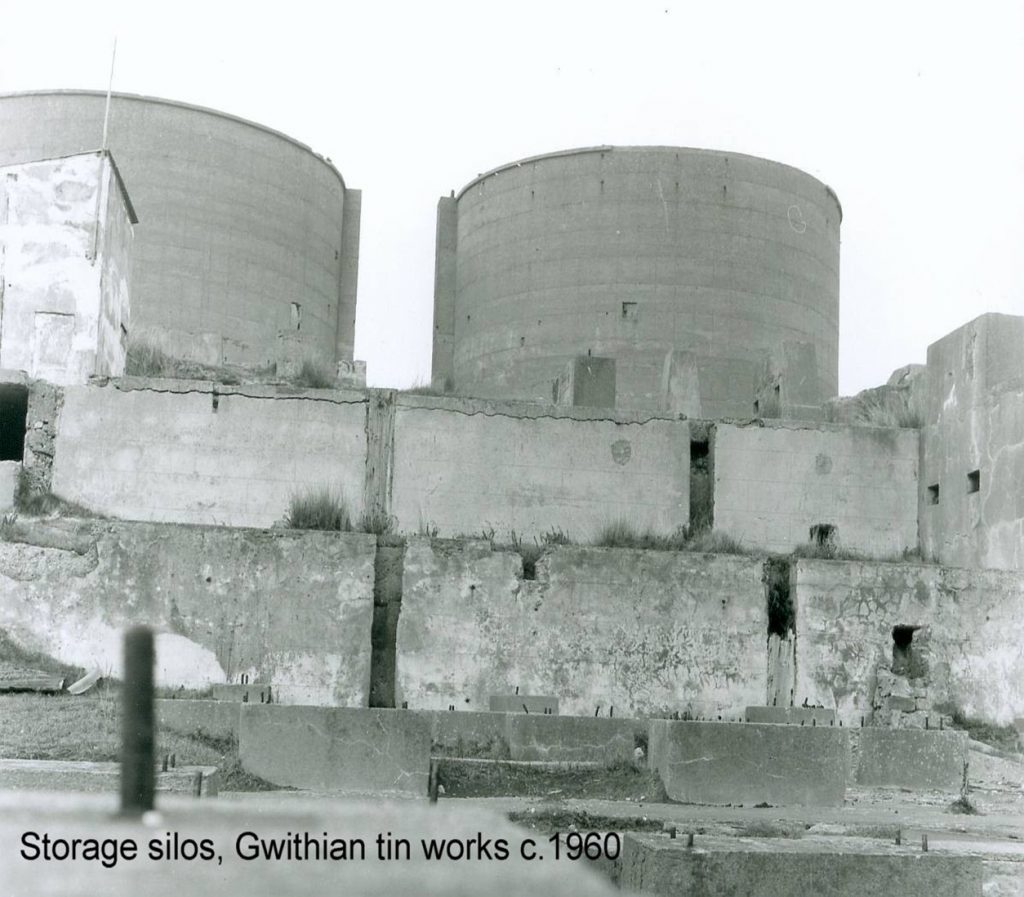
David Oates continues his story of Gwithian Tin Sand Works with a reflection on the Processes and People.
In part 1 we saw how ancient geological forces coupled with the industriousness of man over the centuries led to this part of the Red River Valley, and the adjacent shoreline, becoming a depository for tin ore, mostly lost from the recovery processes of the mines in and around Troon and Camborne. It looked at the many and ingenious ways the tin bearing sand was brought to the processing plant. Part 2 looks at that recovery process and some of the human stories associated with this undertaking. The processes are presented here in a fairly basic form as much of the technical detail needs specialist explanation and goes beyond the remit of this piece.
We have records of tin recovery here since, and before, the beginning of the twentieth century and although we can put some flesh on characters who lived and worked here from an early period, much of the detail of that recovery dates from the most recent workings in the period between the two World Wars. Part 1 told us how the Red River had effectively been canalised during the nineteenth century presumably to both concentrate the flow and bring water to the most accessible and suitable place to erect processing equipment. The next picture shows that site as it is today with little sign of the work carried out here. The remains of the treatment works were cleared in the mid-twentieth century in connection with a plan to extract alluvial tin from the sea-bed along this part of the north coast stretching from here to the area off St Agnes, another prolific mining area. That venture never came to fruition, but we do have a photographic record that gives some sense of what was destroyed in the preliminary planning for this.
 Site of the most recent processing floors near the mouth of the Red River cleared in the mid-twentieth century.
Site of the most recent processing floors near the mouth of the Red River cleared in the mid-twentieth century.
 The building housing the processing plant in the 1930s on the approximate site pictured previously.
The building housing the processing plant in the 1930s on the approximate site pictured previously.
Most of the photographic evidence still extant dates from the period when this building was erected to house the dressing floors. This process took advantage of the natural lie of the land as much of this sort of tin recovery relies on that simplest of forces – gravity. Here, even at this relatively early time when many houses still didn’t have electricity, the process was electrically powered and the slurry of tin containing sand was pumped to the highest point of the processing plant, from where it was treated on a variety of equipment to separate the tin ore from the waste. This picture also shows the chimney serving a calciner – a kind of furnace used to roast the tin ore to remove the arsenic that was both an impurity and a by-product. We have no information from this site but much Cornish arsenic production was sold in the southern USA to kill the boll weevil on the cotton crops.
 This picture shows part of the mill during construction. The tiered concrete walls are evident in later photos of the site in ruins. Note the typical Cornish wheelbarrow with large wheel.
This picture shows part of the mill during construction. The tiered concrete walls are evident in later photos of the site in ruins. Note the typical Cornish wheelbarrow with large wheel.
 Shaking table for tin recovery – courtesy of King Edward Mine Museum
Shaking table for tin recovery – courtesy of King Edward Mine Museum
All the methods for recovering tin were used at the site including the traditional round buddles, the foundations of which are still evident near the chimney. The methods used inside the mill however employed two devices – the James shaking table and the Frue Vanner. Both used the basic principle of passing the slurry across a moving surface, in the case of the shaking table slightly inclined as well. As the slurry passed across the surface, the water and gravity washed the lighter waste material away and the heavier tin was collected at one end. In the picture at King Edward Mine the tin is clearly shown as a dark streak on the higher level of the table. The Frue vanner was more sophisticated and consisted of an endless moving belt onto which the slurry was deposited with the same result. They sometimes re-treated the concentrate obtained on the shaking table.
 Frue vanners at Dolcoath Mine similar to those used in the mill at Gwithian.
Frue vanners at Dolcoath Mine similar to those used in the mill at Gwithian.
 Site of the mill c. 1960 showing the foundations for the shaking tables and vanners. All destroyed in the project to dredge tin from the bay which was never brought to a conclusion.
Site of the mill c. 1960 showing the foundations for the shaking tables and vanners. All destroyed in the project to dredge tin from the bay which was never brought to a conclusion.
 Storage silos to contain tin sand brought from the beach and towans – each held 1,000 tons and are situated above the mill (tiered walls as seen in photo of mill being constructed).
Storage silos to contain tin sand brought from the beach and towans – each held 1,000 tons and are situated above the mill (tiered walls as seen in photo of mill being constructed).
One silo took the tin sand from the aerial ropeway that brought the wind-blown sand found away from the shore and nearer the village of Gwithian while the other took the deposits from below the high tide mark. Some of the deposits required grinding to a smaller size and two mills were installed to deal with this – a ball mill used steel balls to achieve this but another device, a tube mill, used the natural materials on site to grind down the deposits. A derrick on the cliff top near the contemporary lifeguards’ hut raised “bullies” or round quartz pebbles from the beach to enable the process. The remnants of this are still visible on the cliff top.
 Base for derrick leg
Base for derrick leg
The works had a number of identities and names, under different managements and, like many other Cornish mining ventures, lurched from one economic setting to another as the world-wide market price of tin was a key element in the survival or demise of Cornish tin recovery.
We have a little anecdotal information about some of the people who worked here particularly in the early and mid-twentieth century and this helps to give colour and depth to what is, otherwise, merely a fairly technical history of an industrial undertaking.
In 1913, Cornish Tin Sands Ltd was managed by a Mr Grey, who lived at Beach House (now the Rockpool Restaurant) with his wife and two daughters. In those days this was an out of the way spot and not easily accessible as blown sand often blocked the only road. In such a remote spot Mr Grey often passed the time shooting rabbits for the pot from the back door. By this time, a phone line had been established with Godrevy Light-house and the Grey family would ring the keeper and play music on an old wind-up gramophone to entertain him. In return, he would ring Mrs Grey and warn her of approaching rain if it was wash-day! It isn’t known if Mr Grey was of Cornish origin but, like many from industrial settings in Cornwall he was a practising Methodist and preached in local chapels with a preference for the thatched chapel at Roseworthy, similar to the now preserved thatched chapel at Gwithian. He owned a cob, named “Lady go lightly” and rode the horse to his preaching appointments. In 1915 the works closed with the advent of WW1 but re-opened the same year under a Captain Stephens. The level of sophistication in recovery was not truly achieved however until 1929 when the works was acquired by the well-known East Pool and Agar mine on the site now occupied by Morrisons’ supermarket and where two engines are preserved by the National Trust. It was during this period that a fascinating tale is told of an incident concerning the tide. Some tin was still brought back to the mill by horse and cart and the story was told by Tom Prisk about something that happened to him, as a boy, and his father, also Tom, who was employed by the works. The reader may recall that this method of recovery was governed by the tide, until a cutting was blasted through the outcrop of rocks and Tom Prisk says his father would bring as many loads as he could back to above high water before the tide came in. He could then re-load it at leisure and take it to the works. Given the tin content of the already wet sand, this was incredibly heavy and could need three or four horse harnessed to the cart to get it back. On most occasions the last load would see the tide lapping around the horses’ hooves and on one occasion when he was with his father, the tide overcame the horses and cart and father cut the horses loose, put his son on the back one, himself on the other and left the cart which was recovered at Godrevy some days later.
It was during this period of ownership by EPAL that a Mr Furze was appointed manager and he oversaw the enlargement and improvement of the plant. Interestingly, like his predecessor, Mr Grey he was a staunch Methodist and when the chapel at Gwithian closed in 1929 – presumably because of a lack of interest – he persuaded the Methodist authorities to re-open it and was a leading light and organist there for many years. The chapel is now preserved for posterity by the generosity of the late Professor Charles Thomas whose family connections with the area are well-known.
When the tin works closed the area was taken over by the Pentewan Sand Works (later by other quarry proprietors in Cornwall) and the lime rich sand was recovered for many years, destroying an extensive dune system and the remains of the dark age settlement of Connerton, buried beneath the sand. Some of this was sold for agricultural purposes but it is worth noting that vast quantities were taken by rail to Plymouth for the extensive re-building needed after the bombing of World War Two. When most of the useful sand was exhausted, it was acquired by Cornwall Council who enabled a lagoon to be created and it is now a local nature reserve.
 The lagoon being created for its final chapter as a nature reserve.
The lagoon being created for its final chapter as a nature reserve.
Many will pass this way and know nothing of its industrial past!
Acknowledgements to:
Tony Clark B.Sc. formerly of Camborne School of Mines for his technical expertise.
The late Robert Cleave for his meticulous research and interviews.
 David Oates is a Cornish bard who has published a history of Troon, entitled “Echoes of an Age”, a guide to Godrevy and Gwithian, “Walk the hidden ways” and a slim volume of his own verse, “Poems from the far west”. His unpublished work includes a reflection on a Cornish childhood, “What time do they close the gates, Mister?” and a fictionalised story for young people based on the extant life of St Gwinear, with the working title, “The son of a king”. David is working on another guide in the “Walk the hidden ways” series, entitled “Hard Rock country”.
David Oates is a Cornish bard who has published a history of Troon, entitled “Echoes of an Age”, a guide to Godrevy and Gwithian, “Walk the hidden ways” and a slim volume of his own verse, “Poems from the far west”. His unpublished work includes a reflection on a Cornish childhood, “What time do they close the gates, Mister?” and a fictionalised story for young people based on the extant life of St Gwinear, with the working title, “The son of a king”. David is working on another guide in the “Walk the hidden ways” series, entitled “Hard Rock country”.
David is a tenor singer with the well-known group, Proper Job based in mid- Cornwall and has collaborated with Portreath musician, Alice Allsworth, to write the lyrics for a number of songs about Cornwall and the Cornish.

Enjoyed as usual!!
The Mr Gray you mention is my great-grandfather, and is indeed of Cornish birth. He was educated at the School of Mines.
At the start of WWI he was sent to Shropshire to mine for lead by the Ministry of War.
My grandfather returned to Cornwall in 1970 with his own young family.
I was one of “Many will pass this way and know nothing of its industrial past!”
I will be walking again with history book in hand. Thank you David.